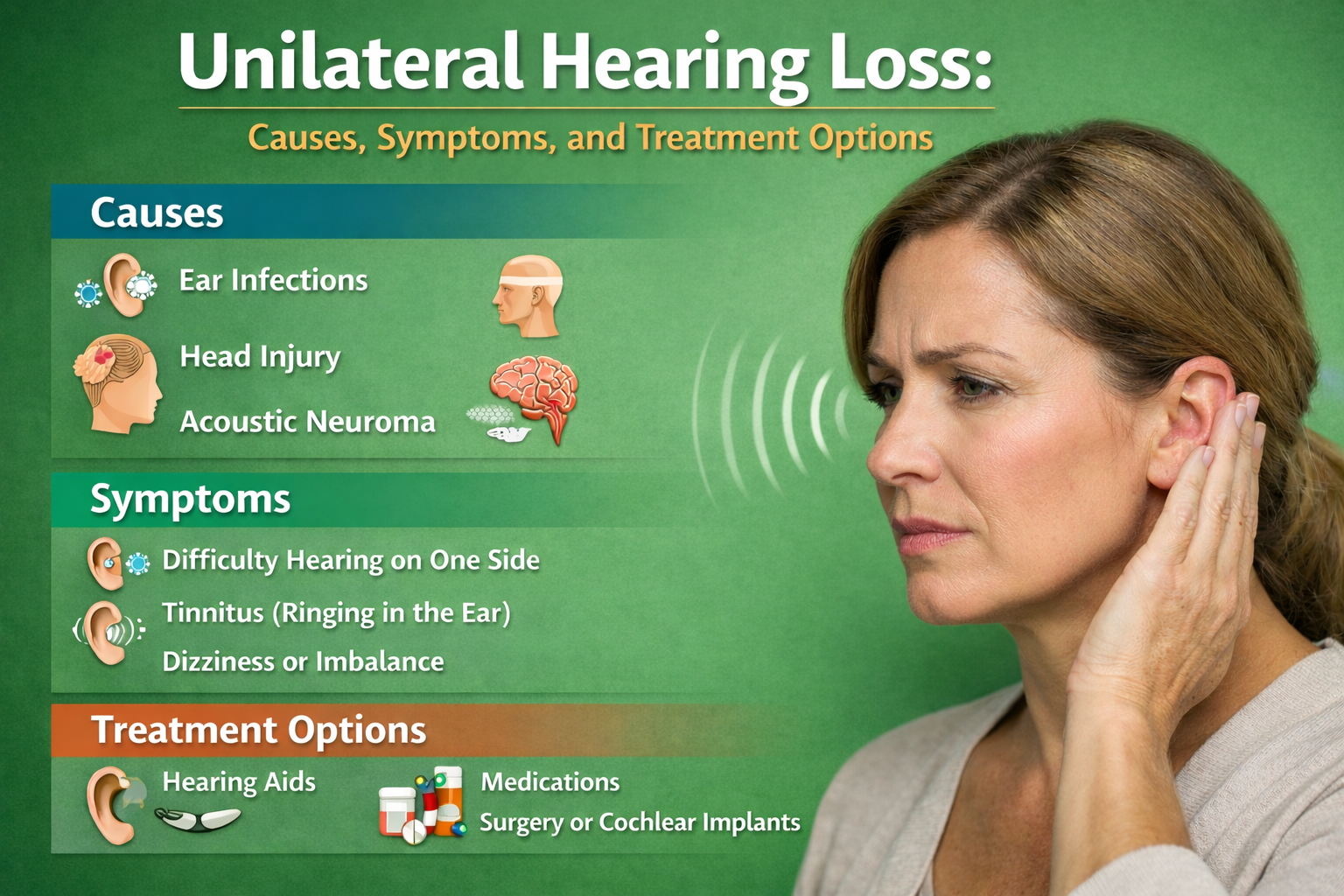Table of Contents
Hearing is one of the most important senses for communication, safety, and quality of life. While most people think of hearing loss as affecting both ears, it can also occur in just one ear. This condition is called unilateral hearing loss (UHL). Also known as single ear hearing loss or one-sided deafness, it can affect both children and adults and may have different levels of severity.
In this detailed guide, we’ll explore what unilateral hearing loss is, its causes, symptoms, available treatment options, and the role of hearing aids for one ear in managing the condition.
What is Unilateral Hearing Loss?
Unilateral hearing loss occurs when a person experiences normal or near-normal hearing in one ear but reduced or no hearing in the other. Depending on the severity, it can be classified as:
- Mild to moderate unilateral loss: Partial hearing reduction in one ear.
- Severe to profound unilateral loss: Little to no hearing in the affected ear, often referred to as single-sided deafness (SSD).
This condition may develop suddenly or gradually and can significantly impact daily life, especially in noisy environments or when trying to identify where sounds are coming from.
Common Causes of Unilateral Hearing Loss
There are several causes of unilateral hearing loss, ranging from temporary blockages to permanent damage. Some of the most common include:
1. Ear Infections
M1iddle ear infections (otitis media) can cause fluid build-up that temporarily blocks hearing.
Chronic infections may lead to long-term damage.
Read more: Ear infection, Ear infection symptoms.
2. Noise Exposure
Exposure to loud noise, such as concerts, explosions, or heavy machinery, may damage the inner ear in just one ear.
3. Sudden Sensorineural Hearing Loss (SSNHL)
A rapid loss of hearing in one ear, often without warning, is usually due to viral infections, blood circulation problems, or unknown reasons.
4. Earwax Blockage
Impacted earwax can create temporary single-ear hearing loss.
5. Head Trauma or Skull Fractures
Injury to the head may damage the auditory system on one side.
6. Tumors (e.g., Acoustic Neuroma)
A benign growth on the hearing and balance nerve may cause one-sided deafness.
7. Congenital Factors
Some children are born with unilateral hearing loss due to genetic or developmental issues.
Symptoms of Unilateral Hearing Loss
The symptoms of unilateral hearing loss can vary depending on its severity and cause. Common signs include:
- Difficulty localising sound (not knowing where the sound is coming from).
- Struggling to hear conversations in noisy places.
- Frequently turning the “good ear” toward the sound source.
- Trouble following group conversations.
- Ringing in one ear (tinnitus).
- Dizziness or balance issues (in some cases).
Even though one ear hears normally, these challenges can create frustration, social withdrawal, and reduced performance at school or work.
Impact of Single-Ear Hearing Loss
Many people underestimate the impact of single ear hearing loss, thinking the “good ear” can fully compensate. However, research shows that unilateral hearing loss can affect:
- Speech Understanding: Especially in noisy or group situations.
- Sound Localization: Difficulty knowing where sounds come from, which is critical for safety (e.g., crossing the road).
- School Performance in Children: Kids with one-sided deafness often struggle with attention, learning, and communication in classrooms.
- Quality of Life: Adults may face challenges in work meetings, social events, and phone conversations.
Diagnosis of Unilateral Hearing Loss
Accurate diagnosis is critical before beginning treatment. At The Hearing Centre, various hearing tests are available, including:
- Pure Tone Audiometry (PTA) – measures hearing thresholds at various frequencies.
- Tympanometry – checks middle ear function.
- Auditory Brainstem Response (ABR/ASSR) – evaluates inner ear and auditory nerve function.
- Imaging Tests (MRI/CT scans) – if a tumor or structural problem is suspected and a proper referral to an ENT specialist will be recommended.
Proper diagnosis helps determine the cause and best treatment options.
Treatment for Unilateral Hearing Loss
The right treatment for unilateral hearing loss depends on its cause and severity. Options include:
1. Medical and Surgical Treatments
- Earwax Removal: If blockage is the cause, professional cleaning restores hearing.
- Antibiotics or Surgery: Treat infections or middle ear fluid.
- Tumor Removal (e.g., Acoustic Neuroma): Surgery or radiation therapy may be required.
- Steroid Therapy: Used in sudden sensorineural hearing loss cases, often within the first 72 hours.
2. Hearing Devices
If medical treatments are not effective, hearing technology can help. Options include:
- Hearing Aid for One Ear
- Amplifies sound in the weaker ear.
- Works well if there is residual hearing.
- CROS (Contralateral Routing of Signal) Hearing Aids
- For one-sided deafness, it picks up sound from the deaf ear and transmits it to the better ear.
- For one-sided deafness, it picks up sound from the deaf ear and transmits it to the better ear.
- Bone Conduction Hearing Aids and Bone-Anchored Hearing Systems (BAHA)
- These non-surgical and surgically implanted devices transfer sound through bone conduction and can be effective for single ear hearing loss. Explore more at Hearing Implants.
- These non-surgical and surgically implanted devices transfer sound through bone conduction and can be effective for single ear hearing loss. Explore more at Hearing Implants.
- Cochlear Implant
- In some severe cases, a cochlear implant may be an option for single-sided deafness.
Hearing Aid for One Ear: How It Helps
For individuals with mild to moderate unilateral loss, a hearing aid for one ear can be highly effective. Benefits include:
- Better hearing in quiet and noisy environments.
- Reduced listening fatigue.
- Improved speech understanding.
- Enhanced confidence in social and professional settings.
It is important to consult an audiologist to determine the best style and technology for your needs.
Living with Unilateral Hearing Loss
At The Hearing Centre, patients can access comprehensive support and recommendation of communication strategies, including:
- Position yourself so your better ear faces the speaker.
- Reduce background noise when possible, choosing a quieter environment
- Use assistive listening devices in classrooms or meetings.
- Seek counselling or support groups to manage emotional impact.
With the right treatment and adjustments, people with unilateral hearing loss can lead fulfilling lives.
Conclusion
Unilateral hearing loss is a condition that affects only one ear but can significantly impact communication, safety, and quality of life.. With proper diagnosis, treatment options such as medical care, hearing aids for one ear, CROS devices, bone-anchored hearing systems, or cochlear implants can greatly improve outcomes.
If you or someone you know is is experiencing symptoms of single ear hearing loss, it is important to consult a qualified audiologist or ENT specialist. Early detection and treatment not only restore hearing ability but also improve social confidence, learning, and overall well-being.
Frequently Asked Questions
It is hearing loss in only one ear, while the other ear hears normally or near-normally.
Causes include ear infections, noise exposure, sudden sensorineural hearing loss, tumors, congenital factors, and head trauma.
It depends on the cause. Some cases (like earwax blockage or infection) are reversible, while others may require long-term management with hearing devices.
Through hearing tests like audiometry, tympanometry, ABR, and imaging scans, if needed.
Unilateral affects only one ear, while bilateral affects both ears.
Yes, some children may born with it, while others develop or acquire it due to infections or trauma.
Treatment includes medical care, hearing aids, CROS devices, bone-anchored systems, or cochlear implants.
Yes, if the hearing loss is limited to one ear and amplification can improve hearing.
This depends on the severity of loss. An audiologist can recommend between traditional aids, CROS devices, or implantable options. Visit the professional to know more details about the available treatment options.
Yes, it can make it difficult to follow conversations, localize sounds, and communicate in noisy places and to some extent it may affect the safety of the individuals with hearing loss.

Evlin is passionate about helping people with hearing loss. With years of experience in audiology, she has diagnosed and treated a wide range of hearing conditions across all age groups. She is accredited to conduct comprehensive hearing assessments and provide treatments for patients from newborns to the elderly. Committed to personalized care, she strives to empower patients to fully engage in life with better hearing.
Designation: Clinical Audiologist
Qualification: Bachelor of Health Science (Honours) (Audiology), University of Science Malaysia
Membership: .Society of Audiology Professionals in Singapore (SAPS)

